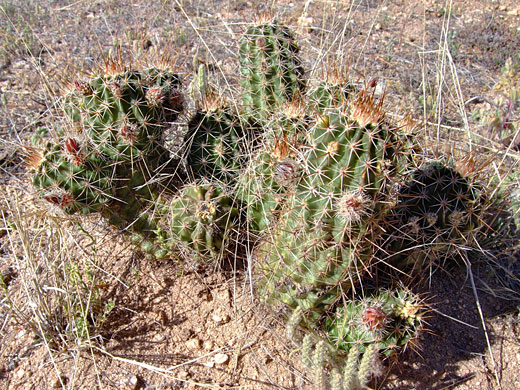Scientific name:
Echinocereus fasciculatus
Common name:
Robust hedgehog cactus, pink flowered hedgehog cactus
Range:
Central and southeast Arizona
Form:
Small clusters, of up to 20 stems
Habitat:
Rocky deserts, scrubland, hillsides
Flowers:
Magenta, violet, purple, with green stigmas

Distribution map for echinocereus fasciculatus
Echinocereus fasciculatus is a sturdy-looking plant with attractive, multicolored spines (eight to 16 per areole), often dark brown at the tips and much lighter near the stem; they are between 0.5 and 3 inches long, varying in length both for individual plants and different specimens. Spines are closely spaced, but not generally dense enough to obscure the green stems, which form small, open clusters. There are between one and three central spines (usually one), and seven to 15 radials.
The large, bright flowers are borne a little way below the apex, and appear in various shades of pink or magenta. Filaments and anthers are yellow, the style peach-colored, and the stigma green.
The plant is quite common within its limited range, in southern Arizona, where it is found between Florence and Nogales, and places a little further east. The cactus resembles several other species including echinocereus engelmannii, though this mostly occupies a different area; one distinguishing feature is the single central spine, cf. engelmannii which has between two and six. Other hedgehog species within this region are bonkerae, coccineus, fendleri, rigidissimus, all relatively easy to distinguish. Echinocereus boyce-thompsonii was once considered a variant but is now classed as a separate species.
The large, bright flowers are borne a little way below the apex, and appear in various shades of pink or magenta. Filaments and anthers are yellow, the style peach-colored, and the stigma green.
The plant is quite common within its limited range, in southern Arizona, where it is found between Florence and Nogales, and places a little further east. The cactus resembles several other species including echinocereus engelmannii, though this mostly occupies a different area; one distinguishing feature is the single central spine, cf. engelmannii which has between two and six. Other hedgehog species within this region are bonkerae, coccineus, fendleri, rigidissimus, all relatively easy to distinguish. Echinocereus boyce-thompsonii was once considered a variant but is now classed as a separate species.
All Contents © Copyright The American Southwest | Comments and Questions | Contribute | Affiliate Marketing Disclosure | Site Map





